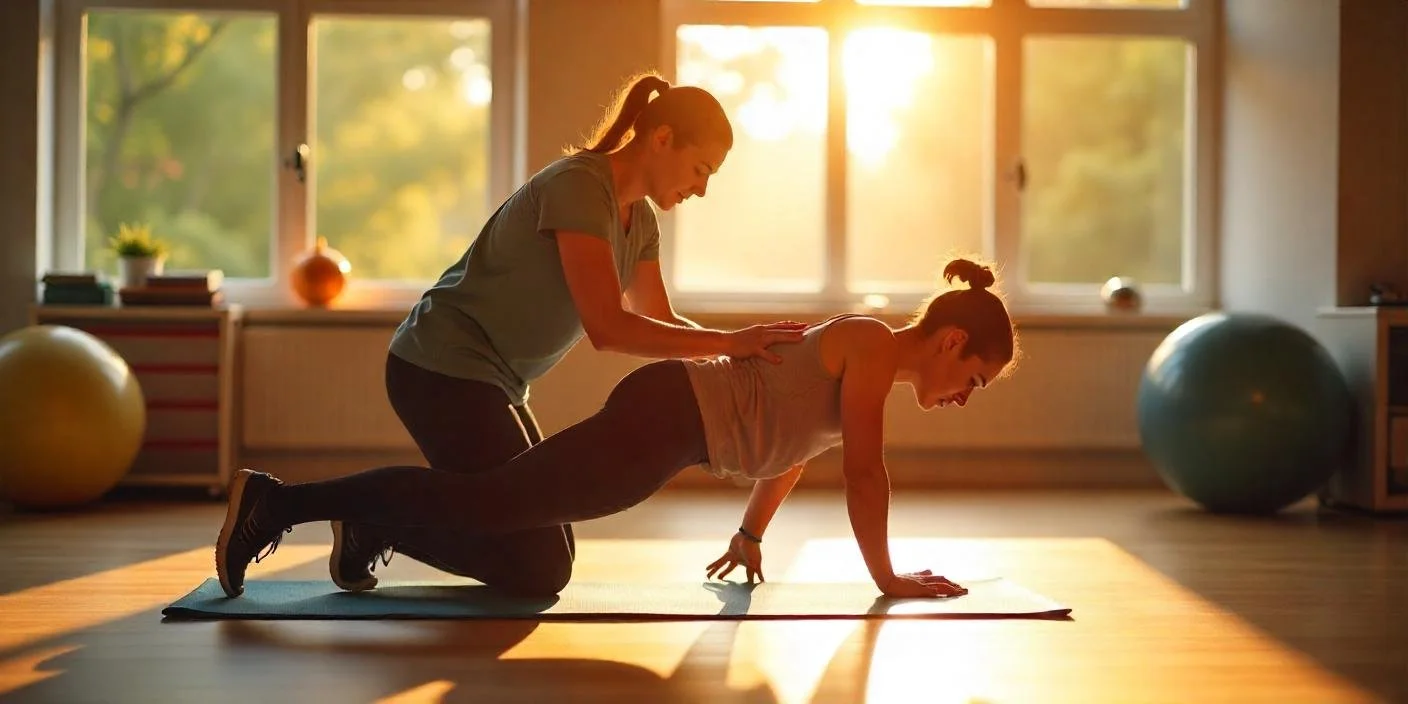Breathing Exercises for Stress Relief: Alleviating Remote Work Stress through Physiotherapy Techniques
In recent years, remote work has become a common aspect of professional life, offering flexibility and convenience. However, this shift has also introduced new stressors and challenges. Many remote workers are finding themselves struggling with stress, which often manifests physically in the form of tension headaches, muscle tightness, and back pain. This article explores how breathing exercises, guided by physiotherapy techniques, can be an effective tool for managing stress and improving physical well-being.
Working remotely can blur the lines between personal and professional life, leading to prolonged hours at the desk and a lack of physical separation from work. This constant pressure often triggers the body's stress response, which can lead to a range of physical symptoms. For instance, stress activates the “fight or flight” response, causing muscles to tense up and increasing the likelihood of tension headaches. If these stress responses are frequent or prolonged, they can contribute to chronic pain and discomfort.
Recent studies have highlighted that remote workers frequently experience musculoskeletal issues, including neck and back pain, as well as headaches. These issues are often exacerbated by poor ergonomics and extended periods of sitting. When our bodies are under stress, the muscles in our neck, shoulders, and back may contract and tighten, leading to discomfort and even pain. Understanding the link between mental stress and physical symptoms is the first step in addressing these issues effectively.
One of the significant factors contributing to physical stress in remote workers is prolonged sitting and poor ergonomic setups. Many remote workers may not have access to ergonomic office equipment, leading to poor posture and muscle strain. Sitting for long hours without proper support can strain the back, neck, and shoulders, making the body more susceptible to stress-related physical discomfort.
Poor ergonomics, such as an unsupportive chair or a poorly positioned monitor, can also contribute to muscle tightness and overall discomfort. When our workspace isn’t set up to support good posture, it can create a cycle of tension and pain that only adds to the stress we’re already feeling.
Breathing’s Role in the Stress Response
Breathing plays a crucial role in managing stress. When we’re stressed, our breathing often becomes shallow and rapid, which can exacerbate feelings of anxiety and physical discomfort. On the other hand, controlled and deep breathing can help activate the parasympathetic nervous system, which promotes relaxation and reduces stress. By focusing on how we breathe, we can directly influence our body’s stress response and alleviate some of the physical symptoms associated with stress.
Physiotherapy-Led Breathing Techniques for Stress Management
The Science of Breathing Techniques
Breathing techniques are more than just relaxation methods; they play a crucial role in managing our body's stress response. Controlled breathing helps regulate the autonomic nervous system, which is responsible for our stress reactions. When practiced regularly, these techniques can lower heart rate, reduce blood pressure, and improve overall well-being. By engaging in specific breathing exercises, we can shift our body from a state of heightened stress to one of calm and relaxation.
One excellent resource for personalized and comprehensive stress relief techniques is your Physiotherapy clinics like AppliedMotion in Perth. AppliedMotion mainly offers tailored pain and stress relief management plans designed to fit individual needs. In addition, the clinic’s experts can help uncover other physiotherapy-related issues that may contribute to ongoing stress. For instance, they can assess and address issues like poor posture or musculoskeletal imbalances that could be exacerbating stress and discomfort.
By integrating breathing techniques with personalized physiotherapy care, such as that offered by AppliedMotion, individuals can receive a more holistic approach to managing stress. This combined strategy not only addresses immediate symptoms but also helps identify and rectify underlying physical issues that contribute to chronic stress.
Diaphragmatic Breathing
Diaphragmatic breathing, also known as deep breathing, involves breathing deeply into the diaphragm rather than shallowly into the chest. This type of breathing helps engage the body’s natural relaxation response, promoting a sense of calm and reducing stress levels. The benefits are numerous: it can lower heart rate, reduce blood pressure, and increase oxygen flow throughout the body.
To practice diaphragmatic breathing, find a comfortable seated position with your back straight. Place one hand on your chest and the other on your abdomen. Take a slow, deep breath in through your nose, allowing your abdomen to rise more than your chest. Exhale slowly through your mouth, feeling your abdomen fall. Repeat this process for several minutes, focusing on the rise and fall of your abdomen rather than your chest. This simple exercise can be done anytime you feel stressed, and with regular practice, it can help manage stress more effectively.
Box Breathing
Box breathing, also known as four-square breathing, is another effective technique for managing stress. This method involves inhaling, holding the breath, exhaling, and holding the breath again, each for the same amount of time. The regular pattern helps calm the mind and body, making it easier to manage stress and anxiety.
To practice box breathing, find a comfortable position and close your eyes. Inhale slowly through your nose for a count of four. Hold your breath for another count of four. Exhale slowly through your mouth for a count of four. Hold your breath again for a count of four. Repeat this process for several minutes. The structured rhythm of box breathing helps regulate the body’s stress response and promotes relaxation.
Alternate Nostril Breathing
Alternate nostril breathing, or Nadi Shodhana, is a yogic practice that balances the body and mind by regulating the breath through each nostril. This technique helps to calm the nervous system and promote a sense of peace and balance.
To practice alternate nostril breathing, sit comfortably with your spine straight. Use your right thumb to close off your right nostril. Inhale deeply and slowly through your left nostril. Close your left nostril with your right ring finger, and release your right nostril. Exhale slowly through your right nostril. Inhale through the right nostril, then close it with your thumb and exhale through the left nostril. Continue this pattern for several minutes. This technique can help balance your energy and reduce stress.
Relaxation Exercises to Release Muscle Tension
Progressive Muscle Relaxation (PMR)
Progressive Muscle Relaxation (PMR) is a technique that involves tensing and then relaxing different muscle groups to help alleviate physical tension. By focusing on each muscle group and consciously releasing tension, you can help reduce overall stress and improve physical comfort.
To practice PMR, find a quiet, comfortable place to sit or lie down. Begin by tensing the muscles in your feet and toes for a count of five, then release the tension and relax for a count of ten. Move on to your calves, thighs, and so on, working your way up through your body. Pay close attention to the sensation of relaxation that follows each release. This exercise can be done as part of your daily routine or whenever you feel tense.
Guided Visualization with Breathing
Guided visualization is a technique that combines breathing with mental imagery to help calm the mind and body. By imagining a peaceful scene while focusing on your breath, you can create a relaxing mental environment that reduces stress.
To practice guided visualization, find a comfortable position and close your eyes. Take a few deep breaths to center yourself. Imagine a serene and calming scene, such as a beach or a forest. As you visualize this place, focus on your breath, inhaling deeply and exhaling slowly. Allow yourself to fully immerse in the imagery and sensations. This practice can help shift your mind away from stress and promote a sense of calm.
Breathing in Combination with Gentle Stretches
Combining breathing with gentle stretches can enhance the benefits of both practices. Stretching while focusing on your breath helps release physical tension and promotes relaxation. Simple stretches targeting areas like the neck, shoulders, and back can be particularly effective for remote workers.
To practice this, try gentle neck stretches while taking deep breaths. Slowly tilt your head to one side, bringing your ear towards your shoulder. Hold for a few breaths, then switch sides. For shoulder stretches, extend one arm across your chest and use the opposite arm to gently press it towards your body. Combine these stretches with deep, calming breaths to relieve muscle tension and enhance relaxation.
Integrating Breathing and Relaxation Techniques into Daily Routine
Simple Practices to Use During Work Breaks
Incorporating breathing exercises and relaxation techniques into your daily routine can significantly improve your stress levels and physical well-being. One of the easiest ways to do this is to use short breaks during your workday. Even just a few minutes of focused breathing or stretching can make a big difference.
Consider setting a timer for short breaks throughout your day. During these breaks, try simple breathing exercises like diaphragmatic breathing or box breathing. For example, take a five-minute break every hour to practice box breathing—inhale for four counts, hold for four, exhale for four, and hold for four. This quick exercise can help reset your stress levels and improve your focus.
Additionally, incorporate brief stretches into your breaks. Simple stretches like neck rolls, shoulder shrugs, and seated twists can help alleviate muscle tightness that builds up from sitting for long periods. Integrating these practices into your workday can reduce physical discomfort and enhance your overall sense of well-being.
Creating a Stress-Relief Routine
Establishing a consistent stress-relief routine can help you manage stress more effectively over time. Creating a routine involves combining different breathing and relaxation techniques into a structured plan that fits your lifestyle.
Start by setting aside specific times each day for stress-relief practices. For example, you might begin your day with a few minutes of diaphragmatic breathing to start the day calmly. In the evening, incorporate guided visualization or progressive muscle relaxation to unwind before bed. By building these practices into your daily schedule, you’ll create a routine that supports your mental and physical health.
Consider also integrating relaxation techniques into your pre-work and post-work rituals. For instance, you might practice alternate nostril breathing to balance your energy before starting work and use box breathing to relax after a long day. This consistent approach helps create a buffer against daily stressors and promotes a balanced, relaxed state of mind.
Long-Term Benefits of Consistent Practice
The benefits of regularly practicing breathing and relaxation techniques extend beyond immediate stress relief. Over time, consistent practice can lead to lasting improvements in both mental and physical health.
Regularly engaging in these techniques can help reduce chronic stress levels, leading to lower blood pressure, improved heart health, and decreased muscle tension. Additionally, incorporating these practices into your routine can enhance your ability to handle stress more effectively. By fostering a calm and centered mindset, you’ll be better equipped to manage work-related challenges and maintain a healthy work-life balance.
Beyond physical benefits, the emotional and psychological advantages of consistent practice are significant. Many people find that regular relaxation and breathing exercises help improve their overall mood, increase resilience, and enhance their ability to focus and stay calm under pressure. As you continue to integrate these practices into your life, you’ll likely notice a positive shift in both your physical well-being and your overall outlook on stress.
In summary
The transition to remote work has brought about new stressors that affect both mental and physical health. By understanding the connection between stress and physical symptoms like tension headaches and muscle tightness, we can take proactive steps to alleviate these issues. Physiotherapy-led breathing techniques and relaxation exercises offer practical and effective solutions for managing stress and improving physical comfort.
Breathing techniques such as diaphragmatic breathing, box breathing, and alternate nostril breathing can help regulate the body’s stress response and promote relaxation. Additionally, practices like progressive muscle relaxation and guided visualization can further support stress relief and muscle tension reduction.
Integrating these techniques into your daily routine—whether through short work breaks, dedicated stress-relief periods, or consistent practice—can lead to significant improvements in your overall well-being. By adopting these practices, you can better manage stress, enhance your physical comfort, and foster a healthier, more balanced approach to remote work.
Remember, managing stress is a journey, and incorporating these techniques into your routine is a valuable step toward improving your quality of life. Embrace these practices with patience and consistency, and you'll likely find that they offer lasting benefits for both your mind and body.











